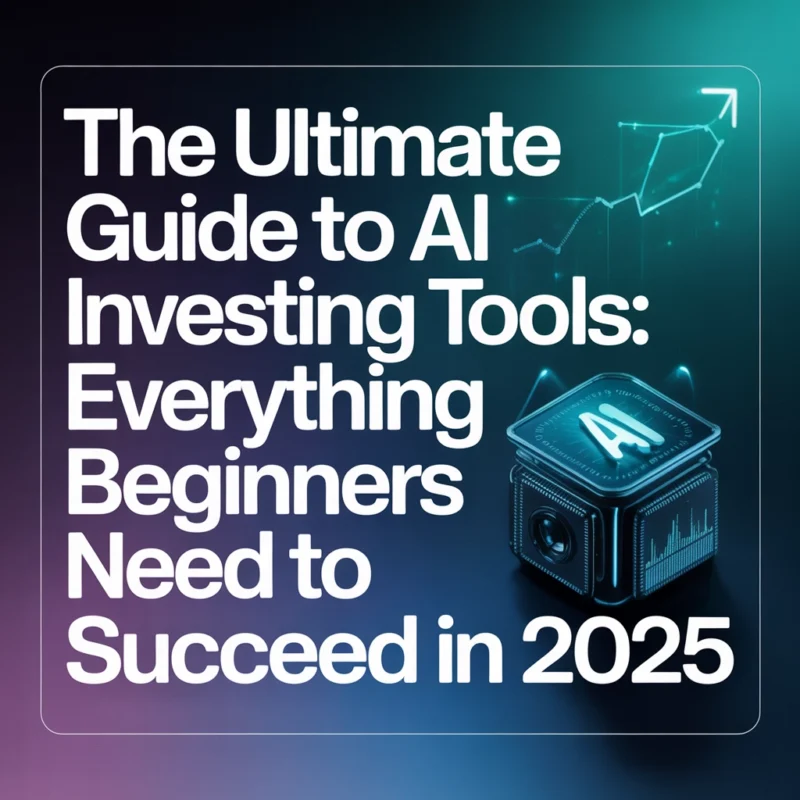Alright, let's talk about something that's completely changing the game for everyday investors like you and me. AI investing tools aren't just some fancy tech that Wall Street bigwigs use anymore: they're now accessible to anyone with a smartphone and a few bucks to invest.
If you've ever felt overwhelmed trying to pick stocks or wondered how the pros seem to know exactly when to buy and sell, AI investing tools might be your new best friend. These platforms can process thousands of data points in seconds, spot patterns that humans would miss, and help you make smarter investment decisions without needing a finance degree.
What Exactly Are AI Investing Tools?
Think of AI investing tools as your super-smart investing buddy who never sleeps, never gets emotional, and can read through thousands of financial reports while you're having your morning coffee. These platforms use machine learning and artificial intelligence to analyze market conditions, assess investment opportunities, and sometimes even manage your entire portfolio automatically.
The coolest part? They can process massive amounts of financial data and analyze trends in real time to help you make better investment decisions. We're talking about tools that can sift through earnings reports, news articles, social media sentiment, and market patterns faster than you can say "buy low, sell high."

The Best AI Investing Tools for Beginners in 2025
Robo-Advisors: Perfect for Set-It-and-Forget-It Investing
Acorns is like having a financial advisor in your pocket. This app is perfect for beginners because it automates micro-investing by rounding up your purchases and investing the spare change. The AI puts your investments on autopilot and uses compound growth to build long-term wealth. It's basically impossible to mess up because the AI does all the heavy lifting.
Wealthfront is another solid choice that creates and manages personalized portfolios based on your risk tolerance and financial goals. The platform gives you access to US stocks, international markets, real estate, and more: all managed by AI algorithms that rebalance your portfolio automatically.
Empower (formerly Personal Capital) combines AI technology with human advisors, which is perfect if you want the best of both worlds. You get automated portfolio management plus access to real financial advisors when you need them.
Advanced Trading Platforms for More Active Investors
Trade Ideas is where things get exciting. This cloud-based platform uses AI to scan the entire market for profitable opportunities and can even execute trades automatically. It's like having a trading assistant that never gets tired and can spot opportunities 24/7. The platform offers backtesting, alerts, charts, and scanners to help improve your trading skills.
Tickeron is particularly cool because it combines AI with human intelligence. It provides 45 different trading idea streams and lets you build AI portfolios with predictive returns. The platform excels at recognizing chart patterns to predict future trends, giving you specific trading signals with success probabilities and AI confidence levels.

How to Get Started Without Getting Overwhelmed
Step 1: Start with Education (Don't Skip This!)
Before you dive into any AI investing tool, spend a week or two understanding basic investing principles. You don't need to become Warren Buffett overnight, but knowing the difference between stocks and bonds, understanding what a P/E ratio is, and grasping basic risk concepts will help you use AI tools more effectively.
Step 2: Choose Your First Platform
For absolute beginners, start with a robo-advisor like Acorns or Wealthfront. These platforms are designed to be foolproof and will teach you investing fundamentals while your money grows. You can literally start with just $5 and learn as you go.
If you're more ambitious and want to be hands-on, consider starting with free tools like TradingView's stock screener to understand basic market analysis before moving to more advanced AI platforms.
Step 3: Start Small and Scale Up
Here's the golden rule: start with money you can afford to lose while you're learning. Most AI investing platforms allow you to begin with small amounts: sometimes as little as $1. This lets you get comfortable with the technology and see how it works without risking your life savings.

Pro Tips for AI Investing Success
Understand What You're Getting Into
AI tools are incredibly powerful, but they're not magic. They analyze historical data and patterns to make predictions, but no algorithm can predict black swan events or sudden market crashes. Think of AI as a really smart research assistant, not a crystal ball.
Diversification Still Matters
Even with AI managing your investments, don't put all your eggs in one basket. The best AI investing strategies typically spread risk across different asset classes, sectors, and geographic regions. Most robo-advisors do this automatically, but if you're using more advanced tools, make sure diversification is part of your strategy.
Keep Your Emotions in Check
One of the biggest advantages of AI investing is that algorithms don't get scared during market downturns or get greedy during bull markets. But you still need to maintain discipline. If your AI tool recommends holding during a market dip, trust the process unless you have a really good reason not to.
Monitor and Adjust Regularly
Set aside time each month to review your AI investing performance. Most platforms provide detailed analytics showing how your investments are performing compared to market benchmarks. Use this data to adjust your risk tolerance or investment goals as needed.

Common Mistakes to Avoid
Chasing Performance: Just because an AI tool had amazing returns last year doesn't mean it'll repeat that performance. Look for consistent, long-term results rather than flashy short-term gains.
Over-Trading: Some AI tools can execute trades very frequently. While this might seem exciting, excessive trading can eat up your profits in fees and taxes. Focus on platforms that align with your investment timeline.
Ignoring Fees: AI investing tools charge fees, and these can add up over time. Make sure you understand the fee structure before committing your money. Generally, robo-advisors charge 0.25% to 0.50% annually, which is reasonable for the service provided.
Setting Unrealistic Expectations: AI investing tools can improve your returns and reduce your workload, but they can't eliminate risk or guarantee profits. Some AI strategies have shown impressive backtesting results: like one that delivered 2,077% total returns in historical tests: but remember that past performance doesn't guarantee future results.
Looking Ahead: The Future of AI Investing
The AI investing landscape is evolving rapidly. New tools are emerging that can analyze unstructured data like news articles and social media sentiment, while existing platforms are getting better at adapting to changing market conditions.
We're also seeing more integration between AI tools and traditional brokers, making it easier to use multiple platforms together. Some newer platforms like Bobby offer conversational AI agents that integrate directly with your trading accounts, while tools like Magnifi specialize in simple account analysis for beginners.

The bottom line is that AI investing tools have democratized access to sophisticated investment strategies that were once available only to hedge funds and wealthy investors. Whether you're just starting your investment journey or looking to upgrade your current strategy, there's likely an AI tool that can help you invest more effectively.
Remember, the best AI investing tool is the one you'll actually use consistently. Start simple, stay disciplined, and let technology work for you while you focus on your long-term financial goals. The future of investing is here, and it's more accessible than ever before.
Want to learn more about getting started with investing? Check out our other guides on Shark Numbers for more beginner-friendly financial education.


